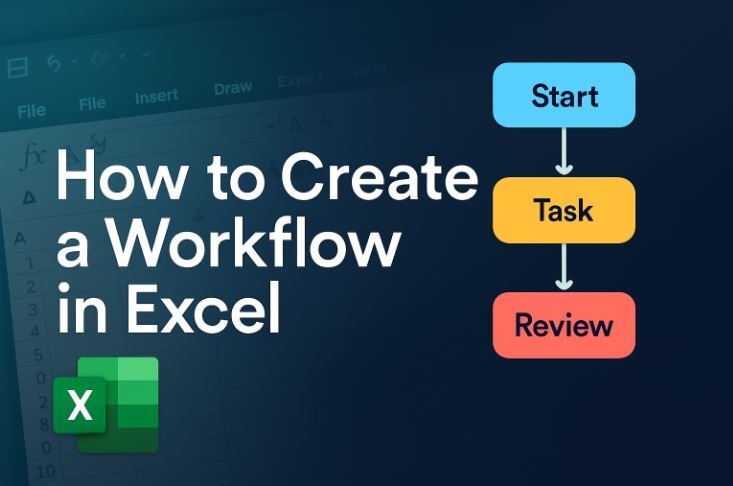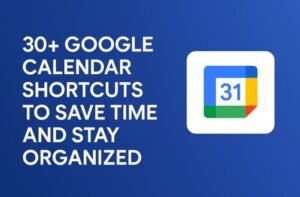Why Workflows in Excel Still Matter in 2025
In an age of automation, AI, and no-code platforms, Excel remains a go-to tool for millions of professionals around the world.
Why?
Because Excel is:
- Familiar and universally accessible
- Flexible and powerful for organizing tasks
- Fully customizable without expensive software
Whether you’re a small business owner, project manager, student, or freelancer, knowing how to create a workflow in Excel will help you save time, avoid mistakes, and stay organized in 2025.
In this guide, you’ll learn how to:
Set up a clear workflow from scratch
Use Excel tools like formulas, conditional formatting, and data validation
Build dynamic workflows with automation using macros or Power Query
Visualize progress with dashboards and status indicators
Let’s dive in!
What Is a Workflow in Excel?
A workflow is a series of steps required to complete a task or project. In Excel, it’s a structured system that tracks tasks, progress, responsibilities, and timelines using rows, columns, and automation.
Common Examples:
- Task tracking and approval processes
- Employee onboarding checklists
- Client follow-up schedules
- Expense reporting or invoice approval chains
Key Components of an Excel Workflow
Before you start, define what your Excel workflow should include:
| Component | Purpose | Example |
|---|---|---|
| Task Name | What the task is | “Send invoice to client” |
| Owner / Assignee | Who is responsible | “Jane Doe” |
| Due Date | When the task should be completed | “2025-04-15” |
| Status | Track progress | “In Progress”, “Completed” |
| Priority | Helps prioritize tasks | “High”, “Medium”, “Low” |
| Notes / Comments | Extra context | “Waiting for client response” |
| Auto Updates | Color changes or alerts | Red when overdue |
Step-by-Step: How to Create a Workflow in Excel
Step 1: Plan Your Workflow Structure
- Decide what tasks or processes you’re managing
- List all necessary columns (e.g., Task, Assignee, Status, Due Date)
- Define clear statuses (To Do, In Progress, Completed)
Tip: Use Excel tables for dynamic filtering and sorting.
Step 2: Enter Sample Data
Start with a small batch of tasks. Example:
| Task Name | Assigned To | Due Date | Status | Priority | Notes |
|---|---|---|---|---|---|
| Write Blog Draft | Sarah | 2025-07-10 | In Progress | High | Scheduled for Thursday |
| Review Edits | Mark | 2025-07-12 | Pending | Medium | Awaiting content draft |
| Publish Article | Sarah | 2025-07-14 | Not Started | High | Needs approval first |
Step 3: Add Data Validation (Dropdowns)
Use dropdown lists to ensure consistency in the “Status” and “Priority” columns.
How to Do It:
- Select column cells (e.g., C2:C100)
- Go to Data → Data Validation
- Choose List, and enter values like:
Not Started, In Progress, Completed
Step 4: Apply Conditional Formatting
Color-code tasks based on status or priority.
Examples:
Red for overdue tasks
Green for completed
Yellow for due in 2 days
How to Do It:
- Select cells in the “Due Date” column
- Go to Home → Conditional Formatting → New Rule
- Use formula like:
=TODAY()>C2→ Format as red
Step 5: Use Formulas for Automation
Add basic automation using formulas like:
Calculate Days Remaining: =DUE_DATE - TODAY()
Progress % Calculation: =COUNTIF(Status_Range,"Completed")/COUNTA(Status_Range)
Step 6: Add Filters and Sorting Options
Use Excel’s built-in Filters to:
View tasks by specific person
Sort tasks by deadline or priority
Focus on “Overdue” or “High Priority” only
Step 7: Create a Visual Dashboard (Optional)
Create a mini dashboard on another sheet using:
- Bar or pie charts showing task completion
- Summary boxes using
COUNTIForSUMIF - Progress bars using Conditional Formatting
Bonus: Automate Excel Workflows with Macros or Power Query
Macros:
Automate repetitive actions (e.g., auto-sorting, form resetting).
- Go to Developer Tab → Record Macro
- Perform actions
- Stop Recording
- Assign macro to a button
Power Query:
- Import, clean, and merge data automatically.
- Best for complex workflows across multiple sheets or files
- Use for daily updates, cross-file tracking, or data cleaning
Excel Workflow vs. Other Workflow Tools
| Feature | Excel | Airtable/Notion/Asana |
|---|---|---|
| Cost | Free with Microsoft license | Freemium/Paid plans |
| Ease of Setup | Beginner-friendly | Requires tool-specific learning |
| Offline Access | ✅ | ❌ |
| Real-time Collaboration | ❌ (unless on OneDrive) | ✅ |
| Automation | Basic with formulas/macros | Advanced (built-in) |
Verdict: Excel remains powerful for lightweight, offline, and solo/team workflows—especially if you’re not ready for full project management software.
Use Case Ideas for Excel Workflows
- Content Calendar & Publishing Workflow
- Hiring Pipeline (Applicant Tracker)
- Sales Follow-Up System
- Event Planning Checklist
- Employee Onboarding Tracker
- Daily Task Schedule + Weekly Planner
- Bug Tracking / Product Feedback
- Invoice and Payment Status Log
- Meeting Agenda & Follow-Up Tracker
- Client Project Management
Expert Tips for Efficient Excel Workflows
- Use TODAY() or NOW() to keep dates dynamic
- Back up often if automating with Macros
- Group related tasks using collapsible sections
- Use “Freeze Panes” to keep headers visible
- Integrate with Outlook or Power Automate for notifications
FAQs: How to Create a Workflow in Excel
Q1: Can Excel really be used like a project management tool?
Yes! While it’s not as sleek as Trello or Asana, Excel is versatile and powerful with the right structure.
Q2: How do I share an Excel workflow with my team?
Use OneDrive or SharePoint for real-time collaboration and version control.
Q3: Is Excel better than Google Sheets for workflows?
It depends. Excel is great offline and for advanced functions. Google Sheets is better for collaboration.
Final Thoughts: Excel Workflows, Reinvented for 2025
Learning how to create a workflow in Excel gives you full control over your data, deadlines, and deliverables—without paying for complex tools.
In 2025, it’s still one of the most effective, accessible, and customizable ways to manage your work—whether you’re in an office, classroom, or remote team.
Ready to build your first Excel workflow?
Download our free template, try a few automations, and share your feedback in the comments. Don’t forget to subscribe for more Excel guides and productivity hacks!




